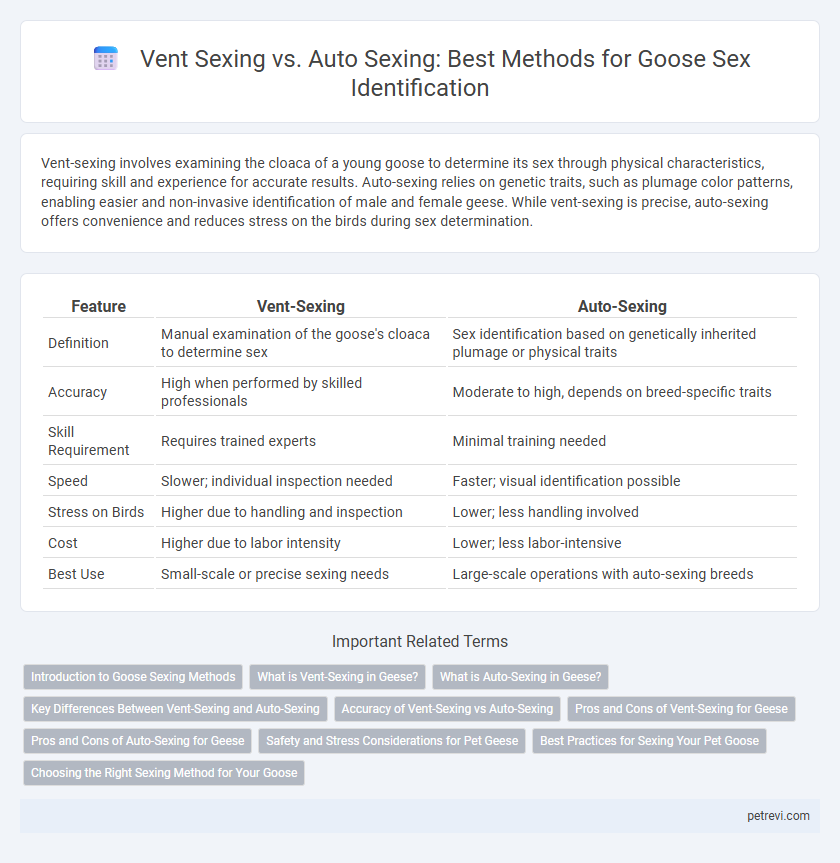Vent-sexing involves examining the cloaca of a young goose to determine its sex through physical characteristics, requiring skill and experience for accurate results. Auto-sexing relies on genetic traits, such as plumage color patterns, enabling easier and non-invasive identification of male and female geese. While vent-sexing is precise, auto-sexing offers convenience and reduces stress on the birds during sex determination.
Table of Comparison
| Feature | Vent-Sexing | Auto-Sexing |
|---|---|---|
| Definition | Manual examination of the goose's cloaca to determine sex | Sex identification based on genetically inherited plumage or physical traits |
| Accuracy | High when performed by skilled professionals | Moderate to high, depends on breed-specific traits |
| Skill Requirement | Requires trained experts | Minimal training needed |
| Speed | Slower; individual inspection needed | Faster; visual identification possible |
| Stress on Birds | Higher due to handling and inspection | Lower; less handling involved |
| Cost | Higher due to labor intensity | Lower; less labor-intensive |
| Best Use | Small-scale or precise sexing needs | Large-scale operations with auto-sexing breeds |
Introduction to Goose Sexing Methods
Goose sexing methods primarily include vent-sexing and auto-sexing, each offering unique advantages for accurate gender identification. Vent-sexing requires skilled handlers to examine the cloaca for subtle anatomical differences, enabling early and precise sex determination. Auto-sexing relies on naturally occurring sex-linked feather or plumage traits, simplifying the process without specialized training but varying among breeds.
What is Vent-Sexing in Geese?
Vent-sexing in geese involves examining the cloacal orifice, or vent, to determine the bird's sex based on subtle anatomical differences. This method requires skilled handlers to gently evert the vent and identify male or female reproductive organs, making it a precise but labor-intensive technique. Vent-sexing is commonly used in breeding programs to accurately sex goslings at an early age for effective flock management.
What is Auto-Sexing in Geese?
Auto-sexing in geese refers to the natural ability to distinguish males from females based on inherent plumage color differences present from hatching. This genetic trait allows breeders to identify the sex without invasive procedures or vent-sexing techniques, which require expertise. Auto-sexing breeds, such as Pilgrim or Cotton Patch geese, provide a more efficient and less stressful method for sex determination in goose farming.
Key Differences Between Vent-Sexing and Auto-Sexing
Vent-sexing involves manually inspecting the cloaca of young goslings to determine sex, requiring skilled expertise and causing potential stress to the birds. Auto-sexing relies on genetic traits such as plumage color or feather patterns that visibly differentiate males from females at hatch, enabling easier and quicker identification. Key differences include the need for trained personnel and invasive handling in vent-sexing versus the non-invasive, immediate, and less error-prone nature of auto-sexing.
Accuracy of Vent-Sexing vs Auto-Sexing
Vent-sexing provides higher accuracy in determining the sex of geese, with success rates often exceeding 90% due to direct examination of reproductive organs. Auto-sexing relies on genetic markers and feather coloration, offering around 85% accuracy but allowing earlier sex identification without handling stress. Selecting vent-sexing ensures precision in breeding programs, while auto-sexing balances accuracy with ease and speed for large-scale operations.
Pros and Cons of Vent-Sexing for Geese
Vent-sexing for geese enables sex determination shortly after hatching by examining the cloacal anatomy, offering early accuracy crucial for breeding programs and flock management. However, its effectiveness relies heavily on the skill and experience of the handler, presenting a steep learning curve that can lead to misidentification and potential harm to the birds if performed improperly. Compared to auto-sexing methods, vent-sexing provides immediate results but requires more specialized training and carries a higher risk of stress or injury to the goslings.
Pros and Cons of Auto-Sexing for Geese
Auto-sexing in geese allows for immediate and accurate identification of sex based on plumage or other physical traits, eliminating the need for expert skills required in vent-sexing. This method reduces handling stress and the risk of injury to birds, promoting welfare and ease in large-scale operations. However, auto-sexing breeds may have limited availability and less genetic diversity compared to those used in vent-sexing, potentially impacting breeding programs.
Safety and Stress Considerations for Pet Geese
Vent-sexing requires careful handling as it involves examining the goose's cloaca, which can cause significant stress and potential injury if performed incorrectly. Auto-sexing breeds, identifiable by distinct plumage or markings, eliminate the need for invasive examination, greatly enhancing safety and reducing anxiety in pet geese. Choosing auto-sexing methods supports welfare by minimizing physical contact and behavioral disturbance during sex determination.
Best Practices for Sexing Your Pet Goose
Vent-sexing offers precise identification of a goose's sex by examining the cloacal opening, requiring expert skill to avoid injury and stress. Auto-sexing relies on inherent physical markers such as feather coloration, size, or behavior, making it a safer and more accessible method for pet owners. Combining these approaches with keen observation ensures accurate sex determination while promoting the well-being of your pet goose.
Choosing the Right Sexing Method for Your Goose
Vent-sexing offers precise accuracy by examining the genitalia of goslings, making it ideal for breeders needing immediate and reliable sex identification. Auto-sexing relies on naturally occurring sex-linked plumage or feather color differences, providing a less invasive and faster method, especially suitable for breeds with distinct sexual dimorphism. Selecting the right sexing method depends on factors like breed characteristics, accuracy requirements, and handling preferences to ensure optimal goose management.
Vent-sexing vs Auto-sexing for Goose Sexing Infographic

 petrevi.com
petrevi.com